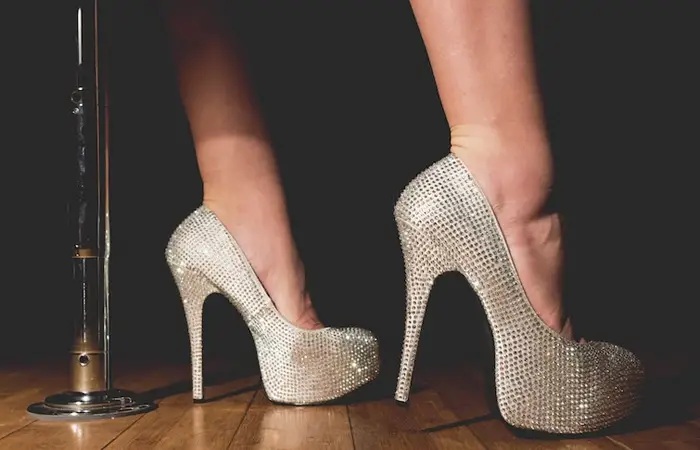One-third of strippers really are putting themselves through college, plus how much money they make and other interesting facts.
As I was researching this list, I Googled “stripper statistics,” figuring it would lead me to some decent academic studies on the industry.
I clicked on a message board link where someone had asked about stripping stats, assuming there would be responses with links. It turned out, though, it was a strippers’ community and their responses could be summarized as annoyed-and-turning-hostile. And I paraphrase…
“It seems like every week someone comes here asking that, like we’re so mysterious and fascinating.” “Write your paper on something else.” “One day, I’m going to flip it and write a paper on how much dishwashers and secretaries make.”
Well, with apologies to all of the strippers out there… I went ahead and kept researching. I found four studies that didn’t use a laughably small sample size and weren’t conducted solely to bash stripping and loathsomely ride the moral high ground.
11 Statistical Facts About Strippers
Strip clubs and exotic dancers (a.k.a. strippers) have always been shrouded in mystery and taboo. But it’s an undeniable fact that they are a significant part of our American culture. Hence, I delved into various resources and extracted these 11 stats (the ones I found most interesting) from those four studies.
So here are the 11 eye-opening statistics and facts about strippers. And for everyone who’s here on a mission for a research paper, I’ve linked my sources.
Leave the strippers to strip and let the nerds guide you to the numbers. There’s no binomial distribution in the champagne room.
1 | One-in-three strippers really *are* putting themselves through college
It’s an old joke that every stripper says she’s just doing it to put herself through school. Even the really old one who’d even Gabrielle Carteris would look at and say, “Yeah, no way she’s college age.”
A study found that 33 percent are, in fact, telling you the truth: It’s college by day, stripping by night. (With no time left over to fight crime. 0 percent are confirmed superheroes.)

2 | The most common reason for getting into stripping is… wanting to dance?
At least that’s what they say. “I just wanted to dance” beats out “I wanted to make more money” or “My job sucked or, uh, didn’t exist.” It’s not all about the money, folks. The money may be an added bonus, but these dancers just shake it because they love it.
And I guess there aren’t that many jobs for the dance majors in America, but exotic dancing seems like a liiitle bit of a stretch. A dance major getting a job in their field by becoming a stripper is kinda like an Italian major getting a job in their field by working at Olive Garden.
3 | About one out of 10 strippers is married
While most married strippers keep their profession hidden from their spouse, a few are open about it and even have the full support of their partner.
Moreover, only 13.5 percent have kids. And yet… somehow the one you get a lap dance from always falls within percentage, and always wants to tell you about ’em.
4 | About one in eight get health benefits
Maybe because the majority of strippers are classified as independent contractors and therefore not entitled to benefits.
However, for the lucky few who do receive benefits, about one in eight strippers get health coverage, and surprisingly, four percent also receive vision coverage. (Although based on the binomial distribution of handsome strip club clientele, being able to see clearly isn’t always a good thing.)
5 | There are wild swings in earning potential
And when we say wild swings, we’re talking about differences in grand.
A top performing male stripper could earn an average of $500 a night. A female exotic dancer earns about $800, and even tops $7,000+ on the best night.
Gender wise, female strippers get paid more due to higher demand than male strippers. Male customers are also generous compared to female audience (for male dancers).
But then again, the pay at the end of a night is extremely variable — it depends on the city, the club, the cut the club takes, the prices, the customer turnout, and how many people are really just there for the $11.99 buffet.
The website Payscale had strippers taking in anywhere from $20,000-a-year to $200,000-a-year.

6 | Some strippers have been in it for decades
The median age is between 23 and 24… but some strippers slug it out WAY longer than that. The five-year mark is usually the point-of-no-return of stripping… get out then, or buy stock in a company that manufactures nine-inch heels.
The breakdown at any given moment in time is about 12 percent of strippers are rookies in their first year… 55 percent have been there one to five years… 19 percent have been there five to nine years… six percent have been there 10 to 20 years… and eight percent of grizzled old veterans have been there more than 20 years.
Twenty years! By that point, you’ve probably inhaled a bushel’s worth of glitter AND could identify Cherry Pie on Name That Tune in two notes. Though this category is a bit different, it still didn’t beat the Fokkens Twins’ record with their 50 years experience in Amsterdam.
7 | One-in-five female strippers has dated a customer; as have three-in-four male strippers
The most surprising part of that? Three-fourths of male strippers have found a woman willing to date them after seeing them hairlessly dance around in a shimmering gold banana thong-ammock.
8 | There are more than nine female strippers for every one male stripper
The industry checks in around 92 percent female, eight percent male, which is essentially the opposite ratio of Google+ before it got shut down in April 2019.
Over the years, the numbers had slightly changed though due to the existence of “prefer to self-define” groups at 1.6%.
9 | 86.3 percent think stripping is a legitimate line of work… eight percent think it’s prostitution
But that’s not to say it’s a different eight percent. It’s not out of bounds to think prostitution is a legitimate line of work. It’s at least as legitimate as being a life coach or personal shopper or storage unit flipper.

10 | Eight out of nine strippers would recommend stripping to a friend
For all the hype about how horrible stripping is, the dominant majority really seem to like it. Unless this is one of those “I’m miserable, come be miserable with me” recommendations. Like being a tour guide at the University of Iowa.
11 | 89 percent were raised in a religious home and 91 percent are still close with their parents
So religion isn’t a magical anti-stripping elixir. If you really want to keep your kid from becoming a stripper, the only guaranteed solution I can think of is to follow the Mr. Belding Buddy Bands axiom and make it uncool… by becoming a stripper yourself. So get on out there and dance.
I mentioned earlier that there were four sources of studies on the facts about strippers I based my list on. But as I updated this article, the other two were no longer available. You can still find much of the info from the sources below.
Sources: